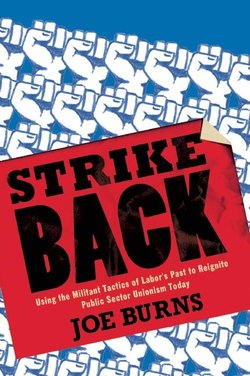Читать книгу Strike Back - Joe Burns - Страница 7
На сайте Литреса книга снята с продажи.
ОглавлениеINTRODUCTION
When I wrote my first book, Reviving the Strike, in 2011, my main focus was on private sector unions, and the urgent necessity of their engaging in traditional tactics, such as the effective strike. While I was pleased with the response to the book, one of the questions that remained unanswered was how public sector unions could engage in militant action, given the repressive state of current labor law.
Since studying the past can help illuminate the present and provide a path for the future, I began to examine an often overlooked era in union history, the public employee strike wave of the 1960s and 1970s. With over half of this today’s union members concentrated in the public sector, and given the high profile of recent public employee battles in Wisconsin and Ohio, examining the historical struggles of public workers seemed a timely and important issue.
Additionally, in traveling around the country discussing Reviving the Strike, many of the workers I spoke with were public employees. What I learned from their experiences—as well as my own background as a union negotiator—was that the labor movement desperately needs new ideas and new sources of inspiration. Barely one-in-twenty private sector workers belong to unions today, the lowest level since the early 1900s. Public employee unions, one of the few remaining strongholds of unionism, are suffering under withering attacks on their legitimacy. Despite this, too many in the labor movement want to continue with business as usual, refusing to address the crisis threatening their very existence.
This is why studying the public employee rebellion of the 1960s and 1970s is so important. During that time, millions of public workers demonstrated and struck in one of the greatest explosions of working class power and militancy in US history. Embarking on this project opened my eyes to an intense period of labor struggle that receives far too little attention from labor historians and activists.
Today’s generation of public employee unionists can learn a lot from this incredible history, in particular, about how to successfully confront repressive labor law. During the 1960s and 1970s, millions of public workers, normally law abiding citizens, protested, marched on school board meetings, and defiantly struck to win collective bargaining rights. The tactics they used are the subject of several chapters of Strike Back, including a discussion of the right to strike. With effective trade unionism outlawed for private sector workers, and more and more public employees being denied bargaining rights, it is not conceivable that the labor movement will be revived in any meaningful way without workers violating labor law, as their counterparts half a century ago did.
Ultimately, the rebirth of the labor movement will be because of bold ideas. It is likely when the labor movement comes back, it will not be in dribs and drabs, but in a great upsurge. Like the Wisconsin public worker protests of 2011, and the Occupy movement, such mass movements seem to come out of nowhere as people move forward in unpredictable ways. Studying the public employee rebellion of the 1960s and 1970s can provide a springboard for discussing ideas to help jumpstart a similar burst of union activism.
But above all, the public employee upsurge of the 1960s and 1970s offer an example of hope, a commodity in short supply for today’s labor movement. Some look at the power of corporate America, declining union density, the attacks on the public sector, and conclude that labor’s time has come and gone. I don’t. Instead, as the story of the 1960s shows, when an idea takes hold, and people organize around it, great things can be accomplished.
